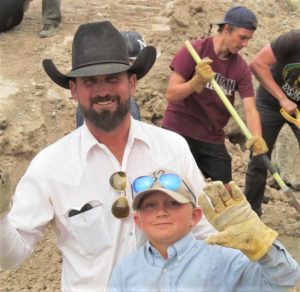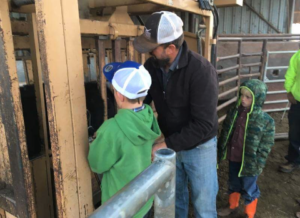
Kevin and his wife, Missy, now run a cow-calf operation in Apache County with the help of their five children.
By Shelby Johnson, Arizona FSA
As a high school student in Round Valley, Arizona, Kevin McFee worked for local ranchers and began growing a herd of his own.
From Angus to Longhorns, Kevin and his wife, Missy, now run a cow-calf operation in Apache County with the help of their five children. Before purchasing their ranch, the McFees picked up leases and bought cattle whenever they could.
“Agriculture is in my blood,” said Kevin. “It’s what I’ve always wanted to do.”
Working the Land
After years of leasing, Kevin and Missy looked into buying land of their own. With a farm ownership loan from USDA’s Farm Service Agency (FSA), the couple became landowners in 2011. FSA’s farm loan programs offer direct and guaranteed loans to farmers and ranchers to promote, build and sustain family farms for a thriving agricultural economy.
“It’s still a work-in-progress, but we’ve done a lot of infrastructure work since 2011,” said Kevin. “We’ve dug a lot of post holes, put in pipe lines, and built interior fences, all to get it where we want it to be.”
Kevin’s family is his main source of help on the ranch. He said the entire operation would not be what it is without them.
“My family is involved in just about everything I do,” he said. “If we need to gather cattle, we do it as a family. If we’re building three miles of new fence, we do it as a family.”
Aside from the ranch, Kevin serves his peers as a member on the Apache FSA County Committee. County committees are unique to FSA and serve as a direct link between agricultural communities across the country and USDA. Producers work to make FSA agricultural programs serve the needs of local producers.

Kevin’s family is his main source of help on the ranch.
Conserving the Land
Teaching their kids to conserve natural resources is important to the McFees. Over the years, they have worked hard to implement conservation practices to provide a better environment for their cattle and the wildlife that live there.
With the help of the Environmental Quality Incentives Program (EQIP), administered by the Natural Resources Conservation Service (NRCS), they have implemented practices to restore native grasslands. Not only does this provide enough forage for both his livestock and native wildlife, but it also protects the soil from erosion.
Through the program, NRCS provides agricultural producers with financial resources and one-on-one help to plan and implement conservation practices. Using these practices can lead to cleaner water and air, healthier soil and better wildlife habitat, all while improving agricultural operations.
“It all boils down to taking care of your grass and your dirt,” Kevin said. “I want to leave my land better than I found it.”
More Information
USDA offers a variety of risk management, disaster assistance, loan, and conservation programs to help agricultural producers across the country weather ups and downs in the market and recover from natural disasters as well as invest in improvements to their operations. Learn about additional programs.
For more information about USDA programs and services, contact your local USDA service center.





